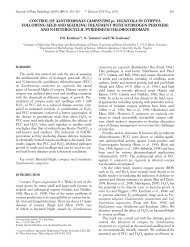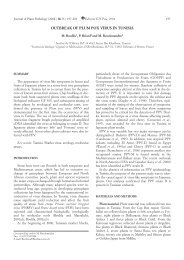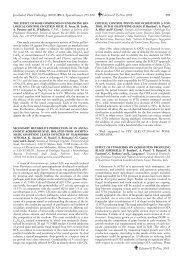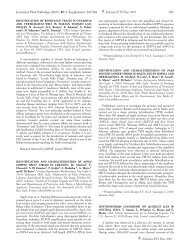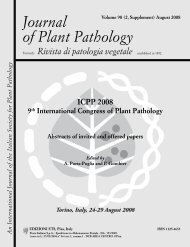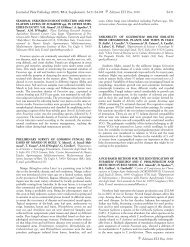Journal of Plant Pathology - Sipav.org
Journal of Plant Pathology - Sipav.org
Journal of Plant Pathology - Sipav.org
You also want an ePaper? Increase the reach of your titles
YUMPU automatically turns print PDFs into web optimized ePapers that Google loves.
S1.32 Efficacy <strong>of</strong> sprays against grapevine powdery mildiew <strong>Journal</strong> <strong>of</strong> <strong>Plant</strong> <strong>Pathology</strong> (2011), 93 (1, Supplement), S1.29-S1.32<br />
(RW%) was only 40% in spite <strong>of</strong> a relatively low disease<br />
pressure in this year. Yet, 7 sprays had the same low effect.<br />
These technical problems in 2002 showed clearly,<br />
that errors in this period are extremely risky in that infections<br />
could not be cleared by further sprays.<br />
During OWP, growers need to work very accurately<br />
against powdery mildew closing the open window, especially<br />
if weather conditions are suitable fungal attacks.<br />
The biggest problems may be caused by infections at<br />
the beginning <strong>of</strong> this period. If the rachis is colonized<br />
by the fungus, sporulation will occur when young<br />
berries are extremely susceptible (Fig. 1).<br />
During the OWP, fungicides against powdery mildew<br />
should be used at short spray intervals, especially if the<br />
weather conditions are suitable for the fungus. All<br />
sprays at other times had a very low relevance for the final<br />
disease levels. These notions were integrated into<br />
the expert system OiDiag 2.2 as an ontogenetic part index<br />
(Kast and Bleyer, 2010). The strong decrease <strong>of</strong> index<br />
values after fruit set demonstrates the decreasing<br />
susceptibility <strong>of</strong> grape clusters.<br />
REFERENCES<br />
Fig. 1. Sporulation <strong>of</strong> powdery mildew (Erisyphe necator) on<br />
the rachis <strong>of</strong> a grapevine bunch.<br />
BBCH55 to BBCH73 are sufficient to control the disease<br />
on grape clusters and that further sprays provide<br />
hardly any benefit. For a better understanding <strong>of</strong> this<br />
problem we propose to introduce the name <strong>of</strong> “Open-<br />
Window-Period” (OWP) for the period starting one<br />
week before flowering and ending a few days after<br />
berries reach 2 mm in diameter (period from BBCH55<br />
to BBCH73). A vine-grower should keep this window<br />
covered by his spray program. During OWP, growers<br />
need an absolutely effective and sure powdery mildew<br />
spray program. Therefore, we recommend using the<br />
best fungicides during this period. Other fungicides<br />
may only be used for further sprays to reduce the production<br />
<strong>of</strong> cleistothecia on the leaves in order to reduce<br />
the overwintering potential.<br />
Since an accident with the tunnel sprayer caused<br />
technical issues, a gap in the spray schedule <strong>of</strong> 18 days<br />
beginning 10 days before flowering (BBCH55) occurred<br />
in 2002. The next spray in all treatments was at the end<br />
<strong>of</strong> anthesis (BBCH69). The effect <strong>of</strong> three sprays<br />
Flaherty D.I., Jensen F., Kasimatis A.N., Kido H., Moller W.J.<br />
(eds), 1982. Grape Pest Management. University <strong>of</strong> California<br />
Publication No. 4105.<br />
Gadoury D.M., Seem R.C., Ficke A., Wilcox W.F., 2003. Ontogenetic<br />
resistance to powdery mildew in grape berries.<br />
Phytopathology 93: 547-555.<br />
Kast W.K., Bleyer K., 2010. The expert system OiDiag2.2 - an<br />
useful tool for the precise scheduling <strong>of</strong> sprays against the<br />
powdery mildew <strong>of</strong> vine (Erysiphe necator Schwein). Proceedings<br />
6 th International Workshop on Grapevine Downy<br />
and Powdery Mildew, Bordeaux 2010: 151-153.<br />
Pearson R.C., Gadoury D.M., 1992. Grape Powdery Mildew.<br />
In: Kumar J., Chaube H.S., Singh U.S., Mukhopadhyay<br />
A.N. (eds). <strong>Plant</strong> Diseases <strong>of</strong> International Importance,<br />
Vol. 3 Diseases <strong>of</strong> Fruit Crops, pp 129-146. Prentice Hall,<br />
Englewood Cliffs, NJ, USA.<br />
Pearson R.C., Goheen A.C., 1988. Compendium <strong>of</strong> Grape<br />
Diseases. APS Press St. Paul, MN, USA.<br />
Stark-Urnau M., Kast W.K., 1999. Development <strong>of</strong> ontogenetic<br />
resistance <strong>of</strong> powdery mildew in fruit <strong>of</strong> differently susceptible<br />
grapevines (cvs. Trollinger and Lemberger). Mitteilungen<br />
Klosterneuburg 49: 186-189.<br />
Travis J., Musza A., Daskopoulos D., Pearson R.C., Gadoury<br />
D.M., Becker C., Ellis M., Ramsdell D., 1994. VITIS, a<br />
grape disease management expert system. Proceedings 1 st<br />
International Workshop on Grapevine Downy Mildew Modeling,<br />
Geneva 1994: 26-30.



